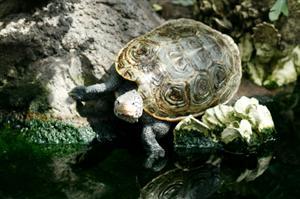| Complexity level: | 6 |
| Project cost ($): | 300 |
| Time required: | It will take 7 days to prepare for this science project, and 3 days observation. |
| Material availability: | Turtles may be obtained from a local pet store. |
| Safety concerns: |
Hypothesis
The Diamondback terrapin will be able to recognize colors.
Overview
Turtles
More than 250 species of turtles are known to exist. The largest turtle is the Leatherback turtle: it can grow up to 2.4meters. The smallest turtle is the Bog turtle: it can only grow up to 10 centimeters in length. Turtles move very slowly when they are on shore. They lay eggs in particular locations, and seldom move from these even after their eggs have hatched. Sea borne turtles are fast swimmers. They travel thousands of miles under water just to find a suitable spot at which they can lay eggs.
Turtles are reptiles - that have a hard shells and a soft body. The shell acts as a shield; it protects the turtles from predators. When a turtle senses danger, it withdraws into its shell. Like all reptiles, turtles are cold blooded. They change their body temperature in order to adapt to the environments in which they live.
Turtles live on land and in water. Those that live mainly on land are called tortoises. Terrapins that are found in North America are also called turtles. Terrapins live in seawater, brackish swamps and fresh water. Turtles are also found in deserts, lakes, marshlands, forest, coastal areas and oceans.
Scientific Terms
Materials
The materials required for this science fair project are as follows:
- 10 Diamondback terrapins
- a blue feeding tray
- a red feeding tray
- a yellow feeding tray
- small fish as turtle bait, or alternatively, turtle feed
Procedure
1. For this experiment, the independent variable is the color of the 3 feeding trays (blue, red and yellow). The dependent variable is the number of turtles that go to the correct food tray. Count how many turtles move towards each food tray. The constants (control variables) are the length of the distance between the food trays and the turtles, and the type of food used as turtle feed. The trays should be identical in shape and size.
2. Prepare the 3 feeding trays. They should be of the same size and shape, but of different colors (blue, red and yellow).
3. Purchase (or if possible, borrow) 10 Diamondback terrapins from a local pet store. Train the turtles for a week: they are to eat from the blue tray. are trained for one week to eat only from a blue color food tray. They will be fed only once a day so that the turtles will learn to recognize and rush to the food tray immediately.
4. After 7 days of training, the turtles are ready to be tested. Arrange the trays in a row and place the food in each of the 3 trays. The blue tray is to be on the extreme left. The red tray is to be in the middle of the 3 trays. The yellow tray is to be on the extreme right. Release the hungry turtles 1meter away from the trays. Count how many turtles go to each tray, and record this in the table below.
5. Repeat procedure number 4 over the next 2 days but place the trays in different positions (red-blue-yellow; red-yellow-blue).

Results
Most of the Diamondback terrapin turtles headed for the blue tray.
| Arrangement | Number of terrapin turtles that headed for each food tray | ||
| Blue tray | Red tray | Yellow tray | |
| Blue-Red-Yellow | 8 | 0 | 2 |
| Red-Blue-Yellow | 9 | 0 | 1 |
| Red-Yellow-Blue | 7 | 1 | 2 |
The graph below represents the results of our science project:

Conclusion
The hypothesis holds true: The turtles recognized colors. Turtles are able to differentiate between colors. They are also able to see well at night.
Diamondback terrapins have diamond patterns on their hard outer shells and hence, their names. They are found in North America and can live in both seawater and freshwater. Mostly, they live in brackish swamps. They feed on small fish, fiddler crabs and mollusks. The Diamondback terrapin is an endangered species, and this is because they were hunted and killed in large numbers in the past.
Also consider
Conduct the experiment in a dark room that does not have light.
Use other species of turtles or tortoises.
Also, try sealing the trays with plastic food wrap (eg. Glad wrap) and observe if there is any difference in the behaviour of the turtles.
References
Turtle - http://en.wikipedia.org/wiki/Turtle
Diamondback terrapin - http://en.wikipedia.org/wiki/Diamondback_terrapin
Turtles and tortoises - http://42explore.com/turtle.htm

